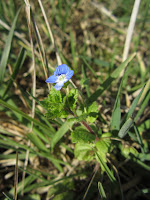With the glorious sunshine this weekend we have been getting outside and making plans for our back garden at Glandford. We are fortunate in having a half acre field as a back garden, but you can still do a lot for the wildlife with a much smaller plot.
 |
| Out the back. |
 |
| Barren Srawberry (Potentilla sterilis) |
 |
| Common field speedwell (Veronica persica) |
Looking in a bit more detail
there are a few wild flowers already coming through including common
field speedwell (Veronica persica),
barren strawberry (Potentilla sterilis),
colt's-foot (Tussilago farfara)
and some other interesting looking stuff coming up that is too small
for me to commit myself to positively identifying yet! Not a bad
start really, but lots more to be done.
 |
| Colt's-foot (Tussilago farfara) |
 |
| The site for the pond. |
Our area designated to
be the pond should be big enough to get a good variety of plants
established and attract dragonflies and have a good diversity of
nooks and crannies in the water and around the edge for other
invertebrates.
Although we have a good
number of fruit-baring bushes with the hawthorn, a bit more choice is
always desirable. Cherry and elder trees provide a good sugar-rich
feast in the summer and apples, especially late fruiting varieties,
are popular with thrushes in the autumn. For the insect-eating birds
flowering and evergreen shrubs are a good idea as well as log piles
and areas of bare soil. Attracting incests is good for the birds,
but they are also fascinating in themselves. One of the best ways to
observe the more flighty insects like butterflies, moths and
dragonflies is with a close-focusing binocular. A lot of modern 8x32
binoculars focus down to less than 2m (6'6''), but the best are the
Pentax Papilio 6.5x21 and 8.5x21 both with a minimum focusing
distance of 50cm (1'8''). Not only are these bins good for seeing
fine detail on a butterflies wings for example, they can also be
quite handy for inspecting the contents of a pond without getting
wet! Our plant shopping list
includes lavender for moths and bees, a buddleia bush or two, a
guelder rose and maybe a rowan tree (mountain ash).
 |
| The old wood burner. |
With the addition of a pile of big
stones, some decoratively arranged railway sleepers and few nest
boxes we'll be sorted for the spring.
Lots more to do, but that should keep us busy for now. We'll keep you up dated.
Cley Spy
This comment has been removed by a blog administrator.
ReplyDelete